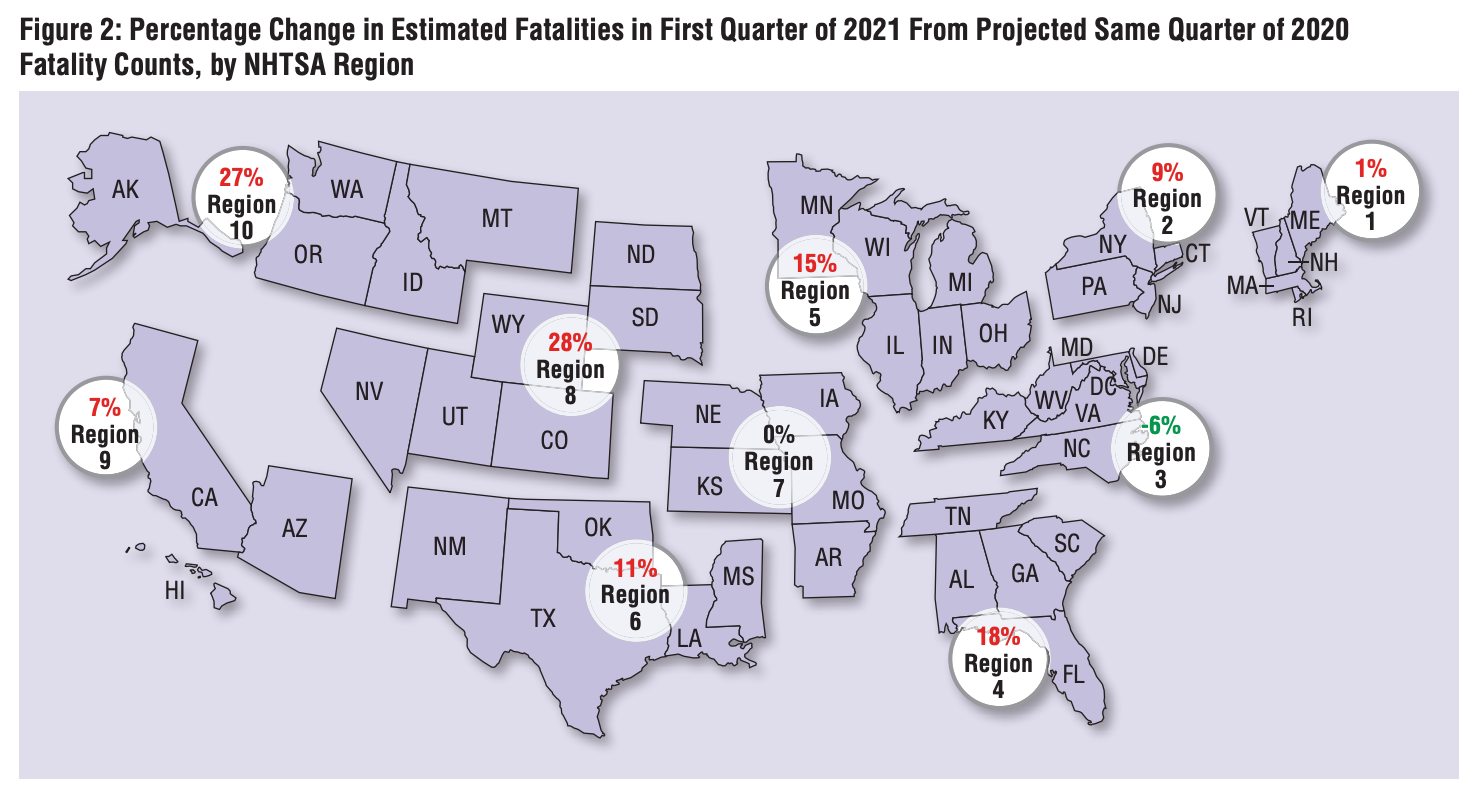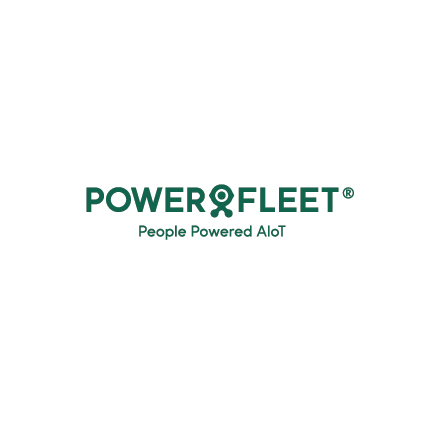The industry has been enduring a challenging operating environment the last few years. Accidents and fatalities are the most considerable existential risk to these companies, given the rise in nuclear verdicts.
Let’s take a look at traffic fatality trends and how you can protect your drivers and business.
Traffic Fatalities Are on the Rise: Here’s How to Keep Your Drivers Safe Click To TweetTraffic Fatalities on the Rise
An estimated 20,160 people died in motor vehicle crashes in the first half of 2021, according to the NHTSA’s latest data, up 18.4% over 2020. While the new report doesn’t account for truck-involved crashes, earlier estimates from the organization show that fatalities involving large trucks were down in 2020 despite an overall increase in traffic deaths.

The mountain west had the most significant increase in fatalities. Source: CCJ Digital
Nevertheless, riskier driving behaviors create an environment that puts truckers companies with commercial fleets at risk. According to the ATRI, the average size of nuclear verdicts against trucking companies skyrocketed nearly 1,000%, from $2.3 million to $22.3 million. And even smaller verdicts have become larger and more frequent.
Start by Hiring Safe Drivers
The best way to keep your fleet safe is to hire safe drivers and ensure they comply with rules and regulations. For example, a driver that starts with a poor record, regularly violates HOS rules, and gets into an accident could lead to a nuclear lawsuit. Meanwhile, a compliant driver with a clean record that gets into an accident is far easier to defend in court.
Start by creating standardized Motor Vehicle Records (MVRs) scores for each applicant and rule out poor performers. In addition, Drive-a-Check (DAC) reports show comments from past employers, while Pre-Employment Screening Programs (PSPs) make it easy to review roadside inspection and FMCSA crash data impacting applicants.
In addition to these minimum standards and best practices, fleets should have their own company-specific standards for years of experience, crash history, and vehicle experience. You may want to work with your insurance provider to define these standards since risky new hires could affect coverage or insurance rates.
Develop Effective Training Programs
Driver training is critical to road safety. Earlier this year, the FMCSA announced new baselines for entry-level truck driver training (ELDT). The new Commercial Drivers License (CDL) curriculum includes both theory and behind-the-wheel training on a range or public road. There are also new registration (TPR) and record-keeping requirements for training programs.
In addition to CDL certifications, companies should provide in-house training programs. These programs should review company-specific rules and regulations, as well as pair new and experienced drivers to verify understanding and answer any questions. In addition, consider ongoing training in specific sub-topics or problem areas.
At the same time, you should diligently document these training programs. That way, if there’s an accident, these records will prove that the company did everything in its power to ensure the driver was competent. If drivers require retraining, you should record the reason and have them sign off.
Identify Problems with Real-Time Data
Real-time information from telematics and dash cameras is quickly moving from nice-to-have to a must-have technology to keep drivers safe. In particular, telematics make it easy to spot unsafe driving behavior before it results in an accident. In addition, the data enables managers to have informed conversations with drivers and measure improvement over time.
Fleets can also use telematics and cameras to develop rewards programs for safe drivers. These programs can foster healthy competition between drivers and encourage safe driving throughout an organization. For instance, you might give away vacation time, gift certificates, or simply offer extra pay for safe drivers when they reach certain milestones.
Finally, telematics can help defend trucking companies if an accident occurs. For example, Powerfleet’s Vista dashcam provides driver- and road-facing cameras to exonerate drivers in the event of an accident and instantly alert them of unsafe conditions. The footage may also be helpful when developing training materials or when retraining drivers.
Benefits Beyond Traffic Safety
The benefits of telematics extend well beyond driver safety, enabling fleets to easily justify investment in new technologies. With a fast payback period and robust return on investment, telematics can improve fleet safety and other operational KPIs.
The other core advantages of telematics include:
- Improve Driver Efficiency: Powerfleet’s telematics can help avoid unnecessary driving, track engine working hours and idling, and help drivers better manage the way they drive to reduce losses and maximize profitability.
- Preventative Maintenance: Powerfleet’s vehicle telematics also constantly track working fleet engine hours, enable you to plan ahead for PM’s, avoid costly failures on the road, and extend asset lifespan.
- Streamlined Customer Service: Powerfleet’s software platform lets you obtain automated arrival and departure notifications from landmarks that you define, and receive reminders to start billing for detention.
- Ensure Compliance: Powerfleet’s Fleet Management solution records all driver activities to the minute, reducing errors, increasing drive time, and providing up-to-the-minute knowledge of available hours to assign to a job.
- Complete Visibility: Powerfleet’s tracking solutions provide complete visibility across your fleet, yards, and customer sites. You can do everything from track vehicle conditions to view the cargo status.
- Maximize Asset Utilization: Powerfleet makes it easy to measure asset utilization to right-size your fleet and ensure the highest possible return on assets. This is especially helpful to maximize revenue during trailer shortages
- Improve the Efficiency of Business Operations: Powerfleet creates the ability to review arrival and departure times, travel time to jobs, and stop duration to know if jobs are being completed in a reasonable amount of time, if there are delays, why detours were taken, and if drivers are not being utilized when they have hours available.
- Eliminate Unauthorized Vehicle Use: With full visibility into assets, Powerfleet makes it easy to find equipment when it is critical.
- Integrated Asset Tracking Eliminate asset theft and address emergency work orders quicker and more efficiently.
- Fuel and battery management: Rank the efficiency of drivers and gain real-time alerts that offer positive live-coaching. Powerfleet also extends the range of battery life.
Powerfleet aggregates these metrics on a powerful cloud-based platform, enabling you to quickly access relevant KPIs, and make data-driven decisions.
The Bottom Line
Traffic fatalities were on the rise last year, creating a more dangerous environment for drivers. With the rise of nuclear and small verdicts, companies are more vulnerable than ever to these kinds of accidents. Fortunately, good hiring practices, effective training programs, and telematics can help avoid and mitigate problems.
If you’re interested in adding telematics to your fleet, Powerfleet has decades of experience with a broad portfolio of solutions.
Contact us today to schedule a free consultation and learn more.
